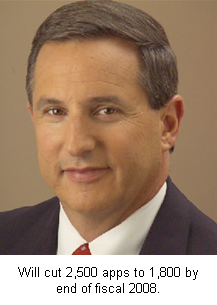HP's Hurd: U.S. demand 'spotty'; Data center, app consolidation continues

HP CEO Mark Hurd was inevitably asked about the U.S. economy during the company's earnings conference call and the message was clear: It's hard to chart tech spending right now.
HP reported a strong second quarter due to sales abroad, but analysts spent a good chunk of time trying to read technology spending. Hurd said (transcript):
U.S., to be specific, was just spotty. We had some very good numbers in the U.S. Cathy (Lesjak, CFO) talked about storage. She talked about business critical systems. IPG had positions of strength, so there's some very -- I could go on. I mean, there were some positions that were very positive and to your point, we are going up against tough compares.
So I hate to give you so much data. I usually try to make it a little bit more concise but the U.S. is a tale of many stories and spotty would be the best way I'd describe it. I wouldn't describe it all bad, but I wouldn't describe it all good, either.
Another notable point: HP is cautious on the U.S. and aligning its inventory accordingly. Hurd said HP has multiple levers to pull, but the true horsepower resides outside the U.S.
The other takeaway on HP's conference call was the company's data center consolidation progress. HP is trying to get down to the 1,500 application level, which is light for a company HP's size. This IT consolidation is important since HP is about to integrate EDS. Hurd noted that HP could house all of EDS on its infrastructure that exists today. Translation: More data center consolidation is on the way.
Here's what Hurd had to say:
We closed the quarter with 2,500 applications running Hewlett-Packard. We've got about 65% of our data centers now closed that we will close. We believe by the end of Q3 we'll be about 90% to 95% of the way through and finish by the fiscal year.
I think we will be at the -- somewhere a little higher than 1500, about 1700, 1800 applications by the end of the year. It's I think 1780 is the destination point. This puts us in a position to do a couple of things.
One, obviously finish off our transformation but to do two things, one to integrate any other acquisitions that we'd do, or at least the one that we talked about last week, which is a big issue for us to be in a position to have that kind of capacity and capability to integrate, and that's significant for us.
Secondly, we've got an opportunity now to start working on our applications and the productivity that comes from the applications now being integrated. We've given examples before that you know, we had 18 planning applications in the company, so I don't know how many different ways you can plan but we found 18 different ways to do it. We now plan one way. I could go down this area by area -- consumer apps where we had 75 and now have one. So the fact that we now have global application sets allow us to now accelerate our productivity sort of process by process as we go across the company.
One last one I'll give you free of charge is we used to deal with our channel partners where anytime a channel partner wanted to give us information, we accepted the format that the channel partner gave us, so we had however many channel partners, that's how many different ways that we accepted data, which isn't just an application, it's different processes.
Getting those all collapsed into one global way to do it gives us an opportunity now to increase our productivity, so darn near completed, very good job I think by our IT, now capable of with capacity to be able to integrate an acquisition like we've talked about, in addition to the fact that we now have a productivity model that allows us to enhance our global applications because we now have a simpler environment.
That's a mouthful, but if you're into IT consolidation Hurd just gave you some good color commentary.